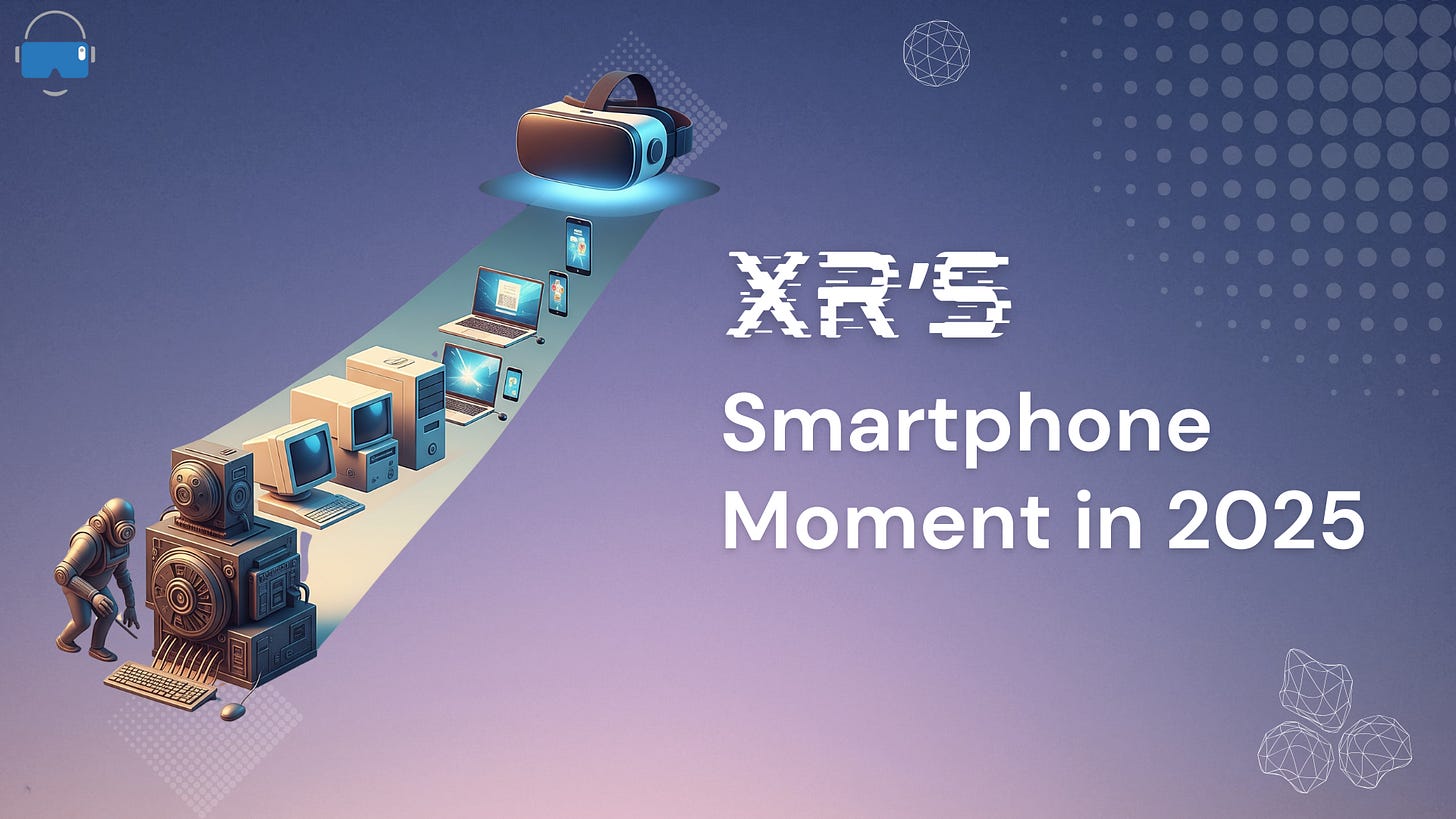Beyond the Hype: Why 2025 is XR's "Smartphone Moment?" – An XR Industry Outlook
GRAHAs VR Newsletter# 53
Remember 2007?
Smartphones, in various forms, had been around for years, serving niche segments with brands like Nokia, BlackBerry, and Palm leading the charge. They were functional, certainly, but not yet the ubiquitous, life-altering devices they are today.
Then came the iPhone.
It wasn't just a new phone; it was a catalyst that ignited an exponential escape velocity for the entire smartphone industry. The iPhone, with its intuitive multi-touch interface and burgeoning app ecosystem, kickstarted an evolutionary journey that redefined personal technology and set the stage for mobile computing dominance.
A similar "genesis" phase for modern Virtual Reality (VR), and the broader Extended Reality (XR) landscape, arguably began with the launch of Oculus. The promise was immense – fully immersive digital experiences that could transform VR gaming, virtual training, and social VR. We're proud that during this foundational period, GRAHAs VR ® was among the pioneering companies in India, actively developing and championing VR solutions from an early stage.
Yet, despite the initial excitement and steady advancements in XR technology, VR hasn't achieved the same meteoric mass adoption as smartphones. Why the slower burn for mainstream XR?
I believe several factors contributed to this. Firstly, XR form factor and complementary technology played a significant role. Early VR headsets, while ground-breaking, were often bulky, tethered, and required powerful, expensive PCs. The evolution of lighter, more powerful computing chips for XR and higher-resolution, more compact display technology for VR/AR, crucial for a seamless XR experience, took time to catch up to the vision.
Secondly, the input mechanism for XR has been a persistent hurdle. While hand tracking in VR has made incredible leaps, many users still find intricate interactions, especially something as fundamental as typing in a virtual environment, cumbersome or unintuitive. This friction point, however small it may seem, can be a significant barrier to daily, prolonged use and wider XR adoption.
The Tides are Turning: XR's Ascent in 2025 – The Future of XR is Now
But today, the XR market is being dramatically redefined. We are witnessing a confluence of advancements that strongly suggest XR is on the cusp of its own "smartphone moment," with 2025 XR trends looking remarkably like 2007 did for mobile.
The advent of AI-powered computing in XR is a game-changer.
Artificial Intelligence (AI) is not just enhancing XR experiences; it's enabling more efficient processing, smarter context awareness, and more natural interactions within virtual and mixed realities (MR). This computational leap is crucial for untethered, powerful, and intuitive AI XR devices and the growth of the Spatial Computing era.
Simultaneously, as the physical form factor of VR and MR headsets continues to shrink, becoming sleeker and more comfortable, we're seeing a parallel revolution in input. Conversational AI for XR is rapidly maturing, positioning voice input in VR/AR as a primary, natural, and highly efficient input mechanism. Imagine navigating complex XR environments or dictating documents with the ease of talking to an assistant – this significantly lowers the barrier to entry and enhances usability, paving the way for XR accessibility.
The industry's giants are not just noticing; they're making monumental bets on the future of XR. We see Apple making waves with its Apple Vision Pro spatial computer, Samsung collaborating with Google on the Android XR OS, a move that echoes the open ecosystem strategy that propelled Android smartphones to global dominance. These investments from tech behemoths signal a clear direction for the XR industry: that is North. The momentum for XR growth is undeniable. Google's latest announcements in the "Google I/O" on 20th May '2025, about their partnership with Samsung on Project Moohan and further development of AI Glasses, add credibility and value to our statements.
And let's not forget the pioneers, the "OGs" of modern VR like Meta with its Meta Quest line and HTC with its Vive series. They have been the torchbearers, consistently pushing the boundaries of VR development through multiple hardware generations and significant software investments in the Metaverse. Their continued aggressive push, born from years of research and user feedback, provides a strong foundation for this next wave of XR innovation.
Adding to this momentum is the anticipation around Apple's next iteration of its spatial computing device. While the first Vision Pro established a new benchmark, history often shows that second-generation products refine the vision and accelerates adoption. No one would forget the roaring success and market expansion driven by the Apple II or the iPhone 3G (the "iPhone 2" in spirit for many, bringing in the App Store and 3G speeds). A more accessible, powerful, or feature-rich successor to the Apple Vision Pro, expected by many later this year or next, could be another significant catalyst for the AR/VR market.
2025: The Inflection Point for XR Mass Adoption
Drawing parallels, 2007 was the year the iPhone showed the world what a smartphone could be, setting the stage for mass market technology adoption. Similarly, 2025 is shaping up to be the year where the convergence of sleeker XR hardware, AI-driven XR experiences, intuitive voice control for XR, and major XR ecosystem plays (like Android XR) will show the world what Extended Reality can be – an indispensable tool for work, learning, communication, and entertainment, moving firmly into mainstream technology.
The journey from niche to mainstream is rarely a straight line. It requires technological breakthroughs, XR ecosystem development, compelling XR use cases, and a critical mass of user adoption. For XR, these elements are aligning more powerfully than ever before. The "smartphone moment for XR" isn't just a distant dream; it's a rapidly approaching reality, and we're thrilled to be building towards this exciting future of immersive technology.
Often, some companies build for the hype and momentum, while others patiently keep transforming the future, burning midnight oil to shine light onto a new generation of products and services. We're happy to be the latter.




